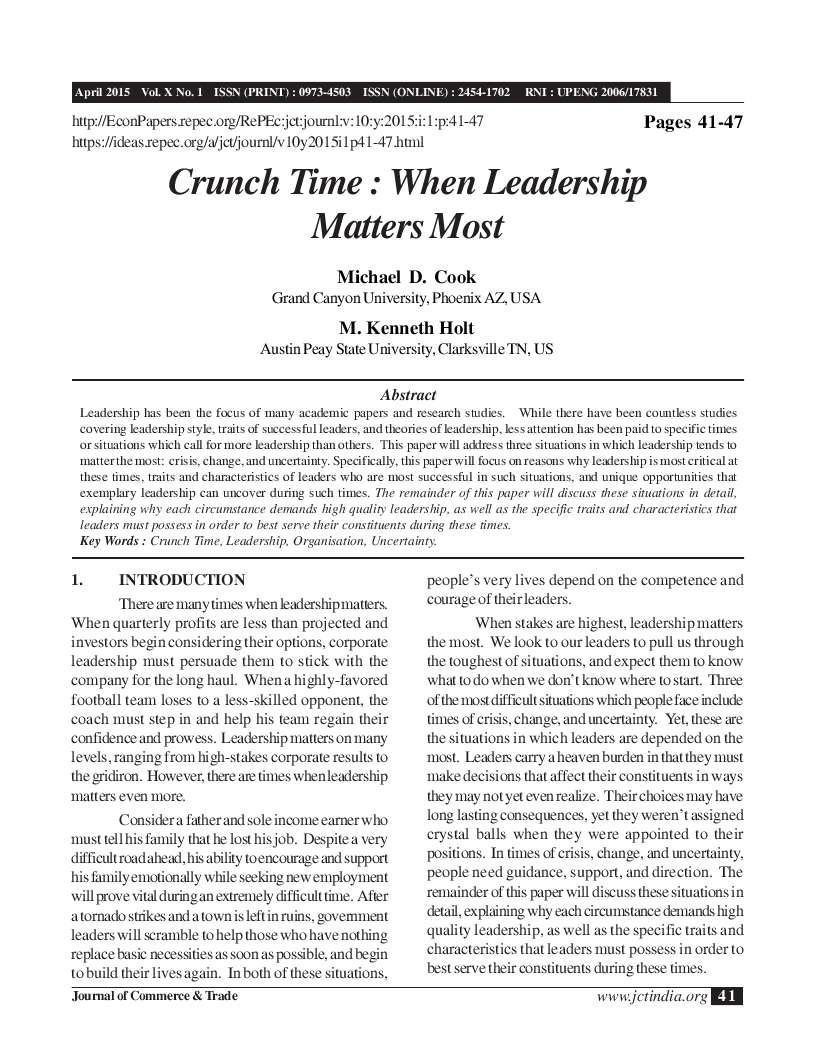Crunch Time : When Leadership Matters Most
DOI:
https://doi.org/10.26703/jct.v10i1.196Keywords:
Crunch Time, Leadership, Organisation, UncertaintyAbstract
Leadership has been the focus of many academic papers and research studies. While there have been countless studies covering leadership style, traits of successful leaders, and theories of leadership, less attention has been paid to specific times or situations which call for more leadership than others. This paper will address three situations in which leadership tends to matter the most: crisis, change, and uncertainty. Specifically, this paper will focus on reasons why leadership is most critical at these times, traits and characteristics of leaders who are most successful in such situations, and unique opportunities that exemplary leadership can uncover during such times. The remainder of this paper will discuss these situations in detail, explaining why each circumstance demands high quality leadership, as well as the specific traits and characteristics that leaders must possess in order to best serve their constituents during these times.
Downloads
References
Ahn, M.J., Adamson, J.S.A., &Dornbusch, D. (2004). From leaders to leadership: Managing change. Journal of Leadership & Organizational Studies, 10(4), 112-123.
Banutu-Gomez, M.B., &Banutu-Gomez, S.M.T. (2007), Leadership and organizational change in a competitive environment. Business Renaissance Quarterly, 2(2), 69-90.
Boin, A. & Hart, P.T. (2003). Public leadership in times of crisis: Mission impossible? Public Administration Review, 63(5), 544-553.
Brooks, I. (1996). Leadership of a cultural change process. Leadership & Organization Development Journal, 17(5), 31-37.
Brumfield, K. (2012). Succeeding in Crisis Leadership. Financial Executive, October 2012, 45-47.
Clampitt, P.G., Dekoch, R.J., & Williams, M.L. (2002). Embracing uncertainty: The hidden dimension of growth. Ivey Business Journal, 66(3), 57-67.
Eisenbach, R., Watson, K., & Pillai, R. (1999). Transformational leadership in the context of organizational change. Journal of Organizational Change Management, 12(2), 80-88.
Grant, R.M. (1999). Transforming uncertainty into success: The strategic leadership forum 1999. Strategy & Leadership, 27(4), 31-36.
Groves, K.S. (2006). Leader emotional expressivity, visionary leadership, and organizational change. Leadership & Organization Development Journal, 27(7), 565-583.
Hunter, D. (2006). Leadership resilience and tolerance for ambiguity in crisis situations. The Business Review, Cambridge, 5(1), 44-50.
Kaye, B. &McDargh, E. (2009). Wanted: Leaders with ESP for tough times. T+D, 63(6), 54-56).
Moerschell, L. & Lao, T.M. (2012). Igniting the leadership spark: An exploration of decision making and punctuated change. Emergence: Complexity and Organization, 14(2), 54-68.
Nebelung, L (2010). Leadership as connection: A radical approach. People & Strategy, 33(4), 48-52.
Schoenberg, A. (2005). Do crisis plans matter? A new perspective on leading during a crisis. Public Relations Quarterly, 50(1), 2-6.
Sweetman, K. (2001). Embracing uncertainty. MIT Sloan Management Review, 43(1), 8-9.
Waldman, D.A., Ramirez, G.G., House, R.J., &Puranam, P. (2001). Does leadership matter? CEO leadership attributes and profitability under conditions of perceived environmental uncertainty. Academy of Management Journal, 44(1), 134-143.
Weiss, R. (2002). Crisis leadership. T+D, 56(3), 28-33.

Downloads
Published
Issue
Section
License
Copyright (c) 2015 Michael D. Cook, M. Kenneth Holt

This work is licensed under a Creative Commons Attribution 4.0 International License.










